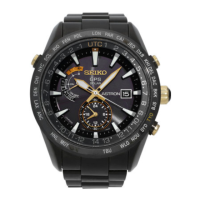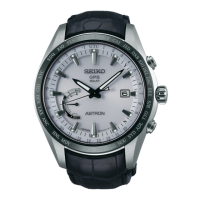What to do if my Seiko ASTRON is unable to receive GPS signals?
- SSean FloydJul 26, 2025
If your Seiko Watch isn't receiving GPS signals, charge it by exposing it to light until the indicator hand points to the middle or full position.
What to do if my Seiko ASTRON is unable to receive GPS signals?
If your Seiko Watch isn't receiving GPS signals, charge it by exposing it to light until the indicator hand points to the middle or full position.
Why does the second hand on my Seiko ASTRON Watch stop at the 45-second position during reception?
If the second hand on your Seiko Watch stops at the 45-second position before reception is completed, especially under low temperatures (0°C or less) where charging capacity and efficiency are lowered, regularly charge the watch by exposing it to light.
Risks of severe injuries if safety regulations are not observed.
Risks of light injuries or material damages if safety regulations are not observed.
Warning against using the watch in scuba or saturation diving.
Cautions regarding water exposure and crown operation.
Explains the watch is a GPS solar watch with specific features.
Details how the watch operates via solar charging.
Explains automatic time adjustment based on usage patterns and light.
How to adjust the time zone when traveling or changing regions.
How to manually adjust the time without changing the time zone.
Identifies and labels the various parts of the watch.
Shows how the indicator hand displays the watch's charging status.
Illustrates how the watch indicates GPS signal reception status.
Explains the indicator for the in-flight mode.
Shows how the indicator hand displays the DST setting.
Lists time zones and their relationship to bezel/dial displays.
Instructions on how to charge the watch by exposing it to light.
Table showing approximate time needed to charge the watch.
Guidance on identifying locations suitable for GPS signal reception.
Steps for setting time zone and date, via GPS or manual input.
How to adjust the watch's time zone by receiving GPS signals.
Considerations when adjusting time zones, especially near boundaries.
How to check the current Daylight Saving Time setting.
Explanation of Daylight Saving Time and its adoption.
Step-by-step guide to manually turn ON Daylight Saving Time.
Step-by-step guide to manually turn OFF Daylight Saving Time.
Prevents GPS signal function from working during flights.
Procedure to activate the in-flight mode on the watch.
Procedure to deactivate the in-flight mode.
How to manually set the time zone when GPS reception is not possible.
Detailed steps for manually setting the watch's time zone.
Explanation of the Global Positioning System (GPS).
How the watch uses GPS signals to set time and date.
Definition and explanation of time zones and UTC.
Explanation of Coordinated Universal Time (UTC).
Explanation of leap seconds and why they are needed.
How the watch automatically receives leap second data.
Guidelines for proper daily cleaning and maintenance of the watch.
Information on watch performance ratings and identification numbers.
Warnings and instructions regarding the watch's secondary battery.
Precautions to take while charging the watch.
Information on guarantee coverage and repair services.
Details on the availability and policy for replacement parts.
Checks to perform when time/date or indicator hand is misaligned.
Explanation of the preliminary position concept for watch hands.
Steps to set the date to the 1st position.
Steps to set the indicator hand to the "E" position.
Troubleshooting common issues related to hand movements.
Troubleshooting issues related to charging the solar battery.
Troubleshooting when the date is incorrect after reception.
Troubleshooting issues with the sub-dial's time display.
Troubleshooting issues with the indicator hand's position.
Steps to take when watch controls are unresponsive or operations are interrupted.
What to do if there is persistent blur on the dial glass.
Identifies time zones and displays precise current time via GPS.
Adjusts time zone via button operation and GPS signals.
Sets precise current time of the set time zone via GPS.
Judges suitable timing for GPS reception and starts it automatically.
Manually changes time zone when adjustment is not allowed.
Allows manual setting of Daylight Saving Time.
Prevents GPS signal function from working during flights.
Displays the number of GPS satellites received.
Displays the latest reception result (success/failure).
Displays the currently set time zone.
Displays time of a different region at the sub-dial.
Corrects hand misalignment due to external factors.
Automatically receives leap second data when necessary.
Risks of severe injuries if safety regulations are not observed.
Risks of light injuries or material damages if safety regulations are not observed.
Warning against using the watch in scuba or saturation diving.
Cautions regarding water exposure and crown operation.
Explains the watch is a GPS solar watch with specific features.
Details how the watch operates via solar charging.
Explains automatic time adjustment based on usage patterns and light.
How to adjust the time zone when traveling or changing regions.
How to manually adjust the time without changing the time zone.
Identifies and labels the various parts of the watch.
Shows how the indicator hand displays the watch's charging status.
Illustrates how the watch indicates GPS signal reception status.
Explains the indicator for the in-flight mode.
Shows how the indicator hand displays the DST setting.
Lists time zones and their relationship to bezel/dial displays.
Instructions on how to charge the watch by exposing it to light.
Table showing approximate time needed to charge the watch.
Guidance on identifying locations suitable for GPS signal reception.
Steps for setting time zone and date, via GPS or manual input.
How to adjust the watch's time zone by receiving GPS signals.
Considerations when adjusting time zones, especially near boundaries.
How to check the current Daylight Saving Time setting.
Explanation of Daylight Saving Time and its adoption.
Step-by-step guide to manually turn ON Daylight Saving Time.
Step-by-step guide to manually turn OFF Daylight Saving Time.
Prevents GPS signal function from working during flights.
Procedure to activate the in-flight mode on the watch.
Procedure to deactivate the in-flight mode.
How to manually set the time zone when GPS reception is not possible.
Detailed steps for manually setting the watch's time zone.
Explanation of the Global Positioning System (GPS).
How the watch uses GPS signals to set time and date.
Definition and explanation of time zones and UTC.
Explanation of Coordinated Universal Time (UTC).
Explanation of leap seconds and why they are needed.
How the watch automatically receives leap second data.
Guidelines for proper daily cleaning and maintenance of the watch.
Information on watch performance ratings and identification numbers.
Warnings and instructions regarding the watch's secondary battery.
Precautions to take while charging the watch.
Information on guarantee coverage and repair services.
Details on the availability and policy for replacement parts.
Checks to perform when time/date or indicator hand is misaligned.
Explanation of the preliminary position concept for watch hands.
Steps to set the date to the 1st position.
Steps to set the indicator hand to the "E" position.
Troubleshooting common issues related to hand movements.
Troubleshooting issues related to charging the solar battery.
Troubleshooting when the date is incorrect after reception.
Troubleshooting issues with the sub-dial's time display.
Troubleshooting issues with the indicator hand's position.
Steps to take when watch controls are unresponsive or operations are interrupted.
What to do if there is persistent blur on the dial glass.
Identifies time zones and displays precise current time via GPS.
Adjusts time zone via button operation and GPS signals.
Sets precise current time of the set time zone via GPS.
Judges suitable timing for GPS reception and starts it automatically.
Manually changes time zone when adjustment is not allowed.
Allows manual setting of Daylight Saving Time.
Prevents GPS signal function from working during flights.
Displays the number of GPS satellites received.
Displays the latest reception result (success/failure).
Displays the currently set time zone.
Displays time of a different region at the sub-dial.
Corrects hand misalignment due to external factors.
Automatically receives leap second data when necessary.
| frequency of crystal oscillator | 32, 768 Hz |
|---|---|
| loss/gain (monthly rate) | ±15 seconds |
| operational temperature range | −10°C to +60°C |
|---|---|
| normal temperature range | 5°C to 35°C |
| power source | Secondary battery, 1 piece |
|---|---|
| duration of operation (fully charged) | Approximately 6 months |
| duration of operation (power save activated) | Approximately 2 years |











